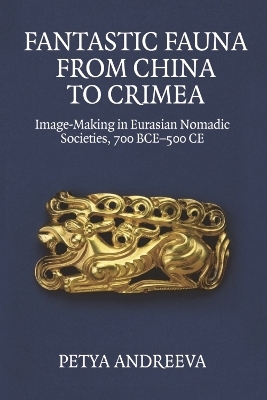
Fantastic Fauna from China to Crimea
Image-Making in Eurasian Nomadic Societies, 700 BCE-500 Ce
Seiten
2024
Edinburgh University Press (Verlag)
978-1-3995-2852-8 (ISBN)
Edinburgh University Press (Verlag)
978-1-3995-2852-8 (ISBN)
Explores the zoomorphic imagination and image-making of Eurasian nomads and their dynamic interactions with neighbouring sedentary empires
Numerous Iron-Age nomadic alliances flourished along the 5000-mile Eurasian steppe route. From Crimea to the Mongolian grassland, nomadic image-making was rooted in metonymically conveyed zoomorphic designs, creating an alternative ecological reality. The nomadic elite nucleus embraced this elaborate image system to construct collective memory in reluctant, diverse political alliances organised around shared geopolitical goals rather than ethnic ties. Largely known by the term "animal style", this zoomorphic visual rhetoric became so ubiquitous across the Eurasian steppe network that it transcended border regions and reached the heartland of sedentary empires like China and Persia. This book shows how a shared fluency in animal-style design became a status-defining symbol and a bonding agent in opportunistic nomadic alliances, and was later adopted by their sedentary neighbours to showcase worldliness and control over the "Other". In this study of enormous geographical scope, the author raises broader questions about the place of nomadic societies in the art-historical canon.
Numerous Iron-Age nomadic alliances flourished along the 5000-mile Eurasian steppe route. From Crimea to the Mongolian grassland, nomadic image-making was rooted in metonymically conveyed zoomorphic designs, creating an alternative ecological reality. The nomadic elite nucleus embraced this elaborate image system to construct collective memory in reluctant, diverse political alliances organised around shared geopolitical goals rather than ethnic ties. Largely known by the term "animal style", this zoomorphic visual rhetoric became so ubiquitous across the Eurasian steppe network that it transcended border regions and reached the heartland of sedentary empires like China and Persia. This book shows how a shared fluency in animal-style design became a status-defining symbol and a bonding agent in opportunistic nomadic alliances, and was later adopted by their sedentary neighbours to showcase worldliness and control over the "Other". In this study of enormous geographical scope, the author raises broader questions about the place of nomadic societies in the art-historical canon.
| Erscheinungsdatum | 07.03.2024 |
|---|---|
| Zusatzinfo | 9 black and white illustrations, 96 colour illustrations, 1 colour map |
| Verlagsort | Edinburgh |
| Sprache | englisch |
| Maße | 156 x 234 mm |
| Themenwelt | Kunst / Musik / Theater ► Kunstgeschichte / Kunststile |
| Geschichte ► Allgemeine Geschichte ► Vor- und Frühgeschichte | |
| Geisteswissenschaften ► Geschichte ► Regional- / Ländergeschichte | |
| ISBN-10 | 1-3995-2852-1 / 1399528521 |
| ISBN-13 | 978-1-3995-2852-8 / 9781399528528 |
| Zustand | Neuware |
| Informationen gemäß Produktsicherheitsverordnung (GPSR) | |
| Haben Sie eine Frage zum Produkt? |
Mehr entdecken
aus dem Bereich
aus dem Bereich
Was Pompeji über uns erzählt
Buch | Hardcover (2023)
Propyläen (Verlag)
32,00 €
auf den Spuren der frühen Zivilisationen
Buch | Hardcover (2023)
C.H.Beck (Verlag)
20,00 €


